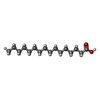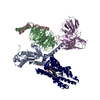登録情報 データベース : PDB / ID : 7t6tタイトル Structure of the human FPR1-Gi complex with fMLFII (Guanine nucleotide-binding protein ...) x 3 Synthetic peptide fMet-Leu-Phe receptor キーワード / / 機能・相同性 分子機能 ドメイン・相同性 構成要素
/ / / / / / / / / / / / / / / / / / / / / / / / / / / / / / / / / / / / / / / / / / / / / / / / / / / / / / / / / / / / / / / / / / / / / / / / / / / / / / / / / / / / / / / / / / / / / / / / / / / / / / / / / / / / / / / / / / / / / / / / / / / / / / / / / / / / / / / / / / / / / / / / / / / / / / / / / / / / 生物種 Homo sapiens (ヒト)Rattus (ネズミ)Bos taurus (ウシ)Homo (哺乳類)手法 / / / 解像度 : 3.2 Å データ登録者 Zhuang, Y.W. 資金援助 組織 認可番号 国 National Institutes of Health/National Institute of General Medical Sciences (NIH/NIGMS) R35GM128641
ジャーナル : Nat Commun / 年 : 2022タイトル : Molecular recognition of formylpeptides and diverse agonists by the formylpeptide receptors FPR1 and FPR2.著者 : Youwen Zhuang / Lei Wang / Jia Guo / Dapeng Sun / Yue Wang / Weiyi Liu / H Eric Xu / Cheng Zhang / 要旨 : The formylpeptide receptors (FPRs) mediate pattern recognition of formylated peptides derived from invading pathogens or mitochondria from dead host cells. They can also sense other structurally ... The formylpeptide receptors (FPRs) mediate pattern recognition of formylated peptides derived from invading pathogens or mitochondria from dead host cells. They can also sense other structurally distinct native peptides and even lipid mediators to either promote or resolve inflammation. Pharmacological targeting of FPRs represents a novel therapeutic approach in treating inflammatory diseases. However, the molecular mechanisms underlying FPR ligand recognition are elusive. We report cryo-EM structures of G-coupled FPR1 and FPR2 bound to a formylpeptide and G-coupled FPR2 bound to two synthetic peptide and small-molecule agonists. Together with mutagenesis data, our structures reveal the molecular mechanism of formylpeptide recognition by FPRs and structural variations of FPR1 and FPR2 leading to their different ligand preferences. Structural analysis also suggests that diverse FPR agonists sample a conserved activation chamber at the bottom of ligand-binding pockets to activate FPRs. Our results provide a basis for rational drug design on FPRs. 履歴 登録 2021年12月14日 登録サイト / 処理サイト 改定 1.0 2022年3月30日 Provider / タイプ 改定 1.1 2022年10月19日 Group / Structure summary / カテゴリ / citation_author / structItem _citation.country / _citation.journal_abbrev ... _citation.country / _citation.journal_abbrev / _citation.journal_id_CSD / _citation.journal_id_ISSN / _citation.journal_volume / _citation.page_first / _citation.page_last / _citation.pdbx_database_id_DOI / _citation.pdbx_database_id_PubMed / _citation.title / _citation.year / _struct.title 改定 1.2 2024年10月23日 Group / Structure summaryカテゴリ chem_comp_atom / chem_comp_bond ... chem_comp_atom / chem_comp_bond / em_admin / pdbx_entry_details / pdbx_modification_feature Item / _pdbx_entry_details.has_protein_modification
すべて表示 表示を減らす
 データを開く
データを開く 基本情報
基本情報 要素
要素 キーワード
キーワード 機能・相同性情報
機能・相同性情報 Homo sapiens (ヒト)
Homo sapiens (ヒト)

 Homo (哺乳類)
Homo (哺乳類) データ登録者
データ登録者 米国, 1件
米国, 1件  引用
引用 ジャーナル: Nat Commun / 年: 2022
ジャーナル: Nat Commun / 年: 2022

 構造の表示
構造の表示 Molmil
Molmil Jmol/JSmol
Jmol/JSmol ダウンロードとリンク
ダウンロードとリンク ダウンロード
ダウンロード 7t6t.cif.gz
7t6t.cif.gz PDBx/mmCIF形式
PDBx/mmCIF形式 pdb7t6t.ent.gz
pdb7t6t.ent.gz PDB形式
PDB形式 7t6t.json.gz
7t6t.json.gz PDBx/mmJSON形式
PDBx/mmJSON形式 その他のダウンロード
その他のダウンロード 7t6t_validation.pdf.gz
7t6t_validation.pdf.gz wwPDB検証レポート
wwPDB検証レポート 7t6t_full_validation.pdf.gz
7t6t_full_validation.pdf.gz 7t6t_validation.xml.gz
7t6t_validation.xml.gz 7t6t_validation.cif.gz
7t6t_validation.cif.gz https://data.pdbj.org/pub/pdb/validation_reports/t6/7t6t
https://data.pdbj.org/pub/pdb/validation_reports/t6/7t6t ftp://data.pdbj.org/pub/pdb/validation_reports/t6/7t6t
ftp://data.pdbj.org/pub/pdb/validation_reports/t6/7t6t リンク
リンク 集合体
集合体
 要素
要素 Homo sapiens (ヒト) / 遺伝子: GNAI1 / 発現宿主:
Homo sapiens (ヒト) / 遺伝子: GNAI1 / 発現宿主:  Spodoptera (蝶・蛾) / 参照: UniProt: P63096
Spodoptera (蝶・蛾) / 参照: UniProt: P63096
 Spodoptera (蝶・蛾) / 参照: UniProt: P54311
Spodoptera (蝶・蛾) / 参照: UniProt: P54311
 Spodoptera (蝶・蛾) / 参照: UniProt: P63212
Spodoptera (蝶・蛾) / 参照: UniProt: P63212

 Homo (哺乳類)
Homo (哺乳類) Homo sapiens (ヒト) / 遺伝子: FPR1 / 発現宿主:
Homo sapiens (ヒト) / 遺伝子: FPR1 / 発現宿主:  Spodoptera (蝶・蛾) / 参照: UniProt: P21462
Spodoptera (蝶・蛾) / 参照: UniProt: P21462 試料調製
試料調製 Spodoptera (蝶・蛾)
Spodoptera (蝶・蛾) 電子顕微鏡撮影
電子顕微鏡撮影
 FIELD EMISSION GUN / 加速電圧: 300 kV / 照射モード: FLOOD BEAM
FIELD EMISSION GUN / 加速電圧: 300 kV / 照射モード: FLOOD BEAM 解析
解析 ムービー
ムービー コントローラー
コントローラー










 PDBj
PDBj

























